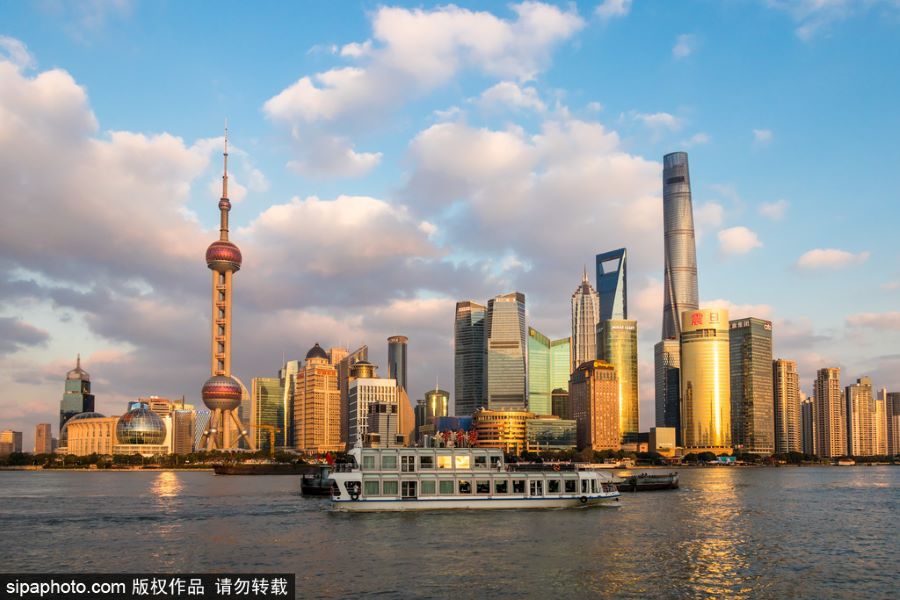
High-rise buildings and skyscrapers dominate the skyline of the Huangpu River and the Lujiazui financial district in Pudong, Shanghai. [Photo/Sipa]
China's external environment has become more demanding since the novel coronavirus pandemic broke out, and the sluggish global economy and rising international competition have created both opportunities and challenges for the Chinese economy. So China should seize the opportunities and meet the challenges, in order to maintain its economic development as well as to boost global economic recovery and improve the global governance system.
On the other hand, the United States' global influence has declined, and the gaps in the military strengths of the US, Russia and China have narrowed.
Besides, the US now sees China as its strategic rivalry and has been desperately trying to check China's rise, by pressuring its allies to boycott China, especially since the pandemic broke out. But despite its best efforts, Washington has not succeeded in its attempts.
By resorting to trade protectionism and unilateral actions, the US has harmed global cooperation while China, Russia and the European Union have been promoting multilateralism and win-win cooperation. In particular, China's efforts to promote peaceful development and democratic international relations have been supported by many countries.
Moreover, if the current world order's basic structure remains intact, China can keep the structural risks under control despite further deterioration of Sino-US ties.
Economic globalization will not end either. The US-centric globalization, established after the end of World War II, reached its peak about a decade ago, but by launching the wars in Afghanistan and Iraq, the US inflicted self-damage on its economy, which impaired its ability to promote US-style democracy in the rest of the world.
Amid all this, China's rise changed the wealth distribution pattern between developed and developing countries, disrupting the US-led global economic order. The US administration's obsession with neoliberalism created new problems for the US economy widening the income gap between the rich and the poor. And its "America first" strategy, withdrawal from international organizations and multilateral agreements, and trade wars alienated the US in the international community, with the White House's poor response to the pandemic dealing another blow to the US' global image.
Worse, the US' attempts to regionalize the global industrial and supply chains harmed globalization, prompting Beijing to take measures to blunt the US' move to decouple China from the global economy. The US' moves also motivated China to develop a "dual circulation" development pattern centered on the domestic economy and aimed at integrating the domestic and global economies, for instance, by boosting regional trade through projects such as the Belt and Road Initiative.
The Fourth Industrial Revolution has heralded a series of social, political, cultural, and economic upheavals that will unfold over next decades. Building on the widespread availability of digital technologies, which are the fruits of the Third Industrial (or Digital) Revolution, the Fourth Industrial Revolution will be driven largely by the convergence of digital, biological and physical innovations
China has basically realized industrialization, and after excelling in low-and medium-end manufacturing, it is now advancing toward high-end manufacturing thanks to the Fourth Industrial Revolution. In contrast, many Western countries have been facing a variety of problems by shifting their manufacturing industries to low-cost developing countries; they are now trying to woo back those industries. In fact, the US has been losing its competitive edge in science and technology, and lags behind China in 5G technology and other high-tech fields because it shifted its manufacturing along with it a part of its R&D establishment to developing countries.
China, on its part, had no option but to independently advance its science and technology sector, and promote innovation. Otherwise, it would have fallen behind in the high-tech race.
Now, China should make good use of its institutional and market advantages to achieve breakthroughs in key technologies, build competitive industrial chain clusters, and create a cutting-edge ecology in science and technology. And irrespective of how good or bad the external situation is, China should deepen reform and further open up its economy to realize high-quality economic development, especially to solve the knotty problems in the post-pandemic era.
The author is an assistance research fellow at the Institute of World Economics and Politics, Chinese Academy of Social Sciences. The views don't necessarily represent those of China Daily.


